Aero on the cheap: How to save watts for less
With wind tunnel access and £5,000 skinsuits an email away, Editor Simon Richardson instead went in pursuit of free speed on a budget
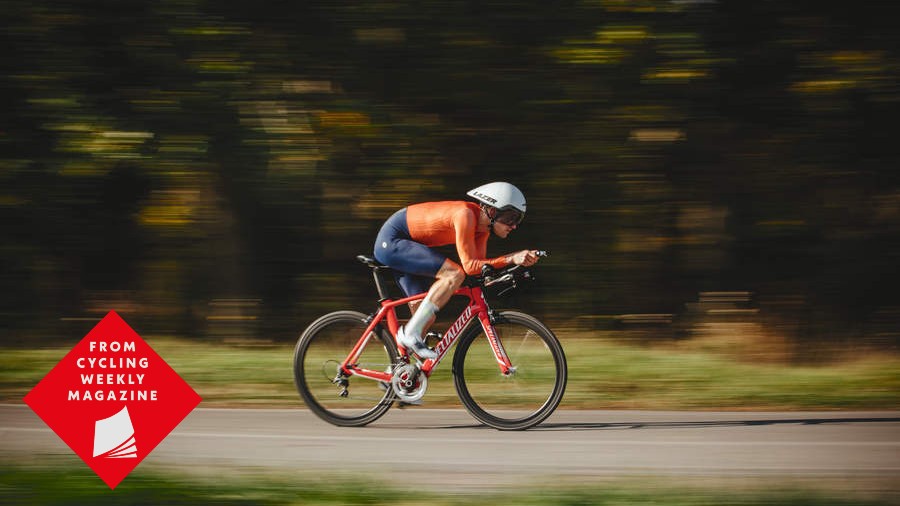

One of the things I missed most through the summer of 2020 was evening races. I’ve always been a fan, from Crystal Palace crits and midweek track league at Herne Hill when I was younger to my club’s evening TTs in recent years. There’s something special about riding to and from a race on a warm summer evening with my friends, getting home just after dark with aching legs and a big appetite.
Having missed a whole season I resolved to ride as many as I could this year. That goal gave me a reason to train and would help me in a bid to log more miles for this year’s CW5000 challenge.
In the past I’d always ridden my club’s evening TTs on my road bike. If I could be bothered I’d chuck on my old Assos skinsuit and on occasion even clip on some mini TT extensions. But most of the time I’d just try and get my elbows in, my head down and pedal as fast as I could.
Then early in 2021 Nopinz got in touch to offer a Pro 1-speedsuit to review. At £139 they’re nowhere near the most advanced on the market, but it’s certainly the slipperiest bit of kit I’ve worn. It got me thinking; how aero could I get? Without knowing my cda, could I get it any lower? Could I get fast enough to post PB’s on my regular circuits, and even beat some of my club mates who for years have regularly got the better of me?
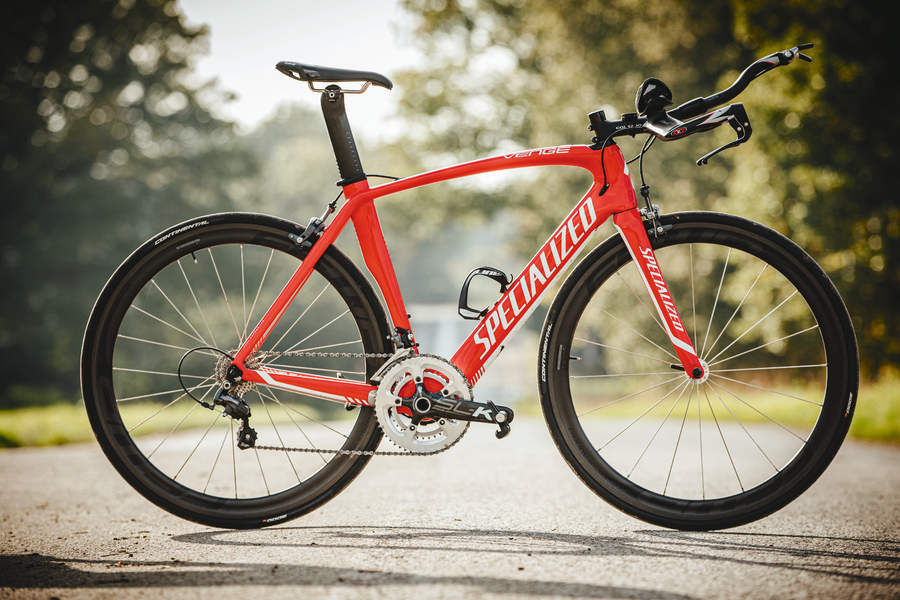
I had an old Specialized Venge road bike (circa 2014) lying around that could be built into a TT bike. Add an aero helmet and I could be on to something. How fast could I get? The thought had gotten into my head and I couldn’t get it out.
Of course, in my role at CW there are plenty of options available to me. A few calls and emails and I could no doubt call in some very nice, very fast, very expensive aero tech to test. There is no shortage of kit and knowledge in the UK. Despite the British time trial scene being known as wonderfully quaint - tea and cake in village halls, course codes and early starts etc. - hidden behind all of that is a sport which has embraced cutting edge aerodynamics for over a decade. Many of those riders hanging around village halls waiting for a scoreboard to be updated will have kit and positions equal to, or even better in some cases, riders in the World Tour.
But something stopped me from going down that road. My love of evening races is the friendly, amateur nature of them and I wanted my aero project to match. Using my position and throwing the kitchen sink at my cda just to beat my clubmates on a Tuesday evening didn’t seem quite right.
Get The Leadout Newsletter
The latest race content, interviews, features, reviews and expert buying guides, direct to your inbox!
So instead I decided I would beg, borrow or steal (re: find old abandoned test kit in the CW stores) for my aero quest. The aim was to combine that with a bit more structured training on the turbo to find out how much faster I could go than previous years.
Can a converted road bike perform as well as a time trial bike?
My first task was to turn the Venge into something that would allow me to ride in a good aero position. It was getting on a bit, in fact it was still 10spd, but repurposing an old bike is a classic right of passage for your common or garden time trialler. There was no better way to join their ranks.
Converting a road bike is however tricky. The 73.5 degree seat tube angle and layback seatpost does not allow for an aerodynamic, low front end and powerful riding position. The saddle needs to be as far forward as possible in order to rotate the hips forwards around the bottom bracket and get a flat back while keeping the hip angle open. I have to admit, shoving a saddle as far forward as it would go was about the limit of my aero positioning knowledge, but as I was to later find out it was key to getting my shoulders as low as possible, which then gets my head down and tucks the tail of a TT helmet inbetween my shoulder blades.
Thankfully I was able to flip the Venge’s seatpin through 180 degrees to reverse the layback. By pushing the saddle forward on the rails I managed to reduce layback to just 62mm. The aim for everyone is the UCI limit of 50mm. So while it wasn’t ideal, it was close enough and better than the 88mm of layback I’d been riding on my road bike.
My hip position would dictate what could be achieved at the front, but first I had to find some TT bars. A quick online search gave oodles of choice and wildly varying costs, but checking in with the tech team brought about a lucky find.
Senior Tech Writer Simon Smythe had an old Easton Attack TT bar gathering dust in his shed. He even had a set of bar end brake levers to fit. These bars are no longer available to buy, but a quick search found an original RRP of £699. That pricetag alone must be worth 30 seconds!
The bike would be rounded out with an old set of FFWD 40mm deep section, rim brake, high pressure carbon wheels. I'd used these in my road bike in previous years, so there was no aero gain to be had there.
Then came the purchases. £50 for the ten speed bar end shifters off of Ebay, £110 for a new chain and cassette and £80 for a new set of tyres.
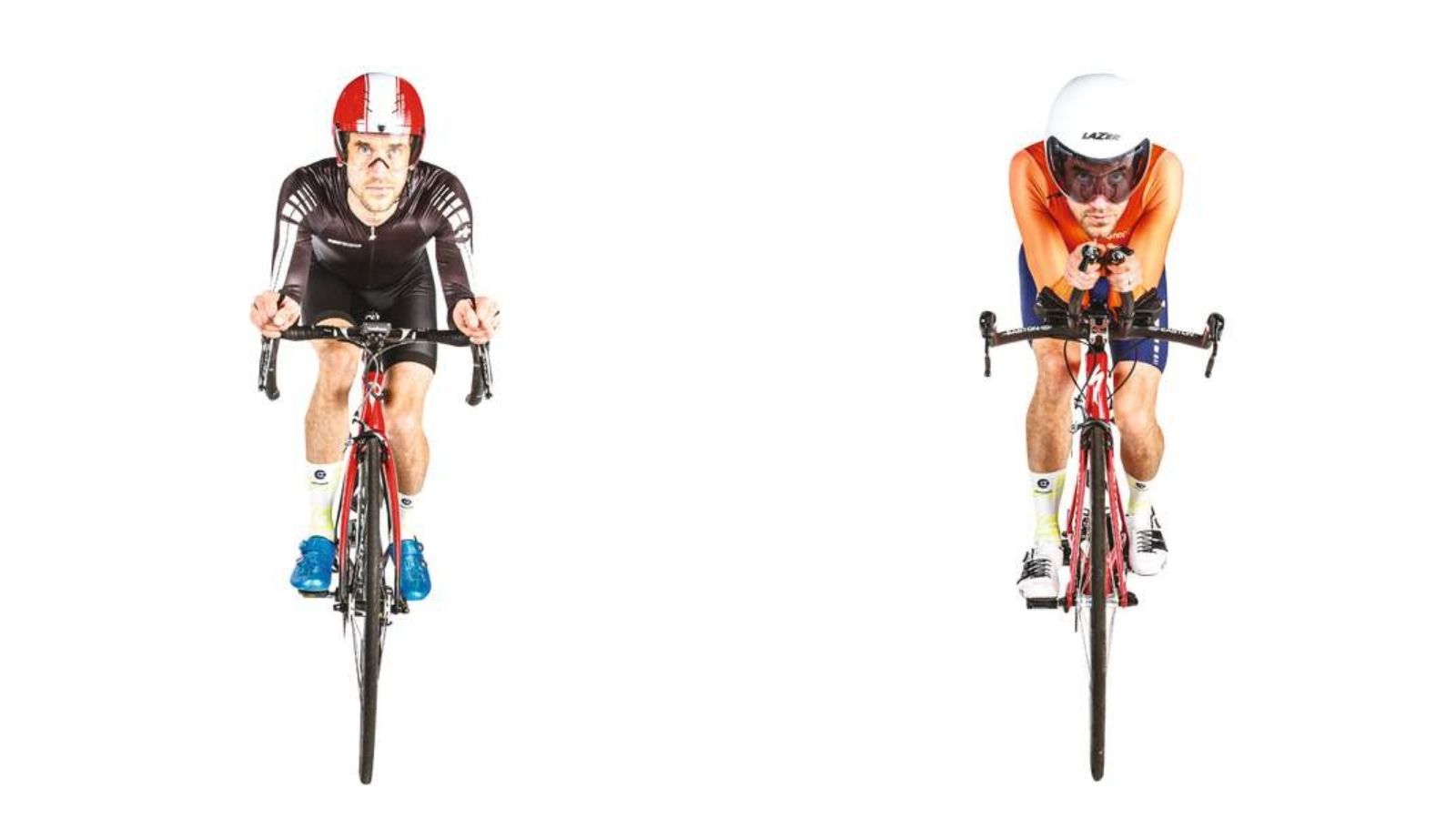
Now came the key part. My position. For this I really needed some aero expertise. In my bid to find some I rang CW columnist and decorated time triallist, Dr Hutch, and asked him if he knew any aero experts.
When I'd stopped laughing at my own joke (there was a strange silence at the other end of the line) I managed to persuade him to come down to our office and see what tweaks he could make.
In truth, I wasn’t giving him much to play with. The saddle was already as far forward as it would go, there was very little adjustment on the Easton bars and he was going to have to do everything by eye. I think the only reason he agreed was that he’d been cooped up at home for so long that he was desperate to get out.
From the get go he was at pains to point out how limited we were by going on sight alone. With no actual data to compute my coefficient of drag (cda) he could make changes that made me slower. The number of ways in which hand position, elbow width, head height, clothing and parts of the bike all interact to alter your cda is seemingly infinite. Make an adjustment to your hand position and it could throw out the air around your TT helmet. Stretch your arms out further and it may affect airflow around your shoulders.
We had to instead focus on the simple task of getting my frontal area as small as possible. There are a few key ways in which to do this. First off, getting my head down. For this I needed a flat black and for this I needed to have my hips rotated as far forward as possible.
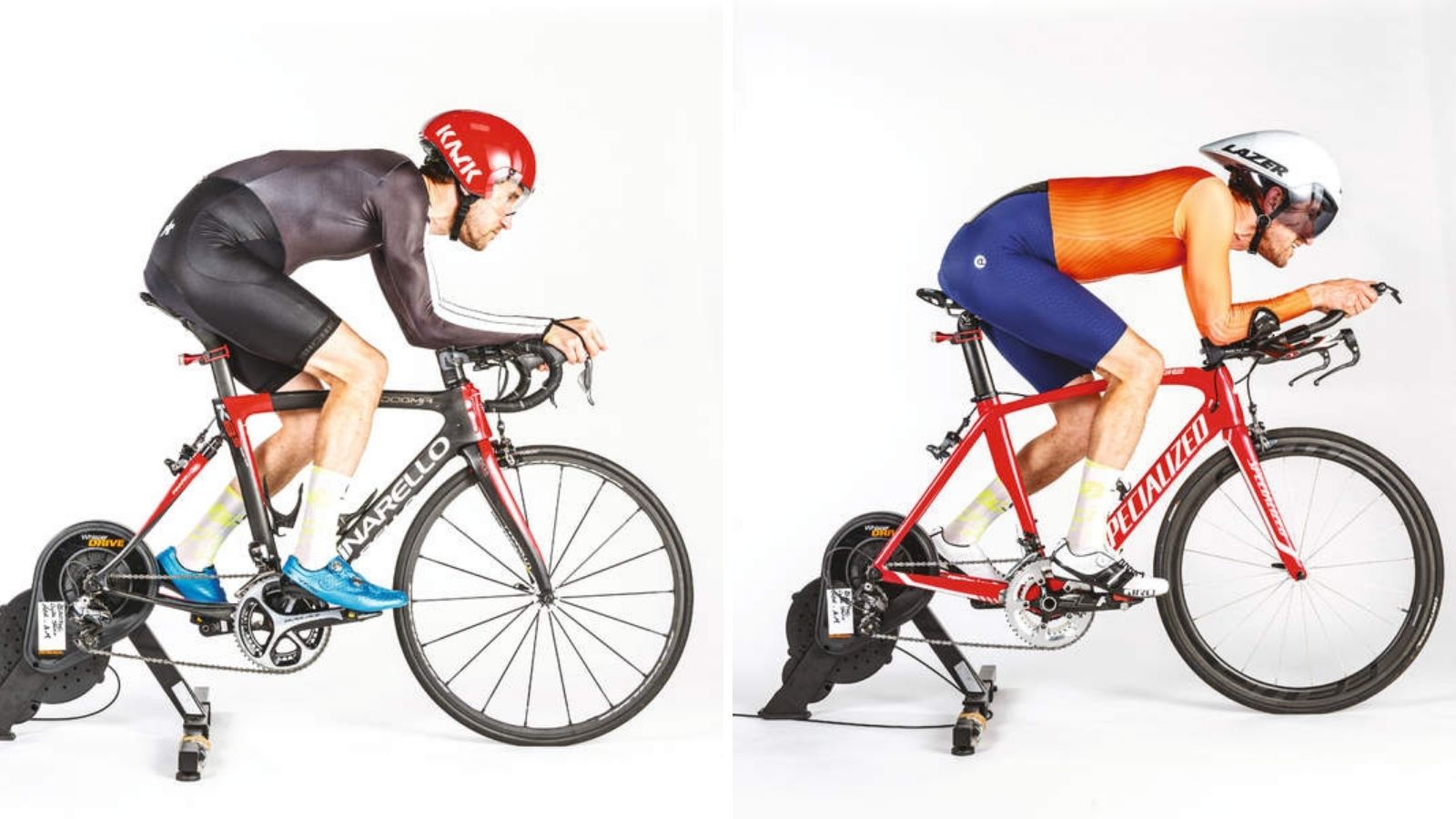
Mine were as far forward as they’d go, so I couldn't have a perfectly flat back. This in turn left my head a little higher than we’d have liked. It was then a case of me tucking my head down and in as much as I could.
Then my elbows. They needed to come in and sit as close together as possible, but again we were limited by the kit. The armrests had minimal adjustment and were already at their inner limit. Neither could we raise them as the Easton bars had no vertical adjustment.
We did however manage to get my elbows a bit closer together by what is commonly known as ‘bodging it’. Hutch looked around and found some foam packaging. He cut out two square pieces and jammed them under the outer half of the pads. This essentially ‘tipped’ my elbows inwards. I later painted these black and superglued velcro to them to make them stick.
The difference they made was immediately obvious. Not only did my elbows come in, they dragged my shoulders with them.
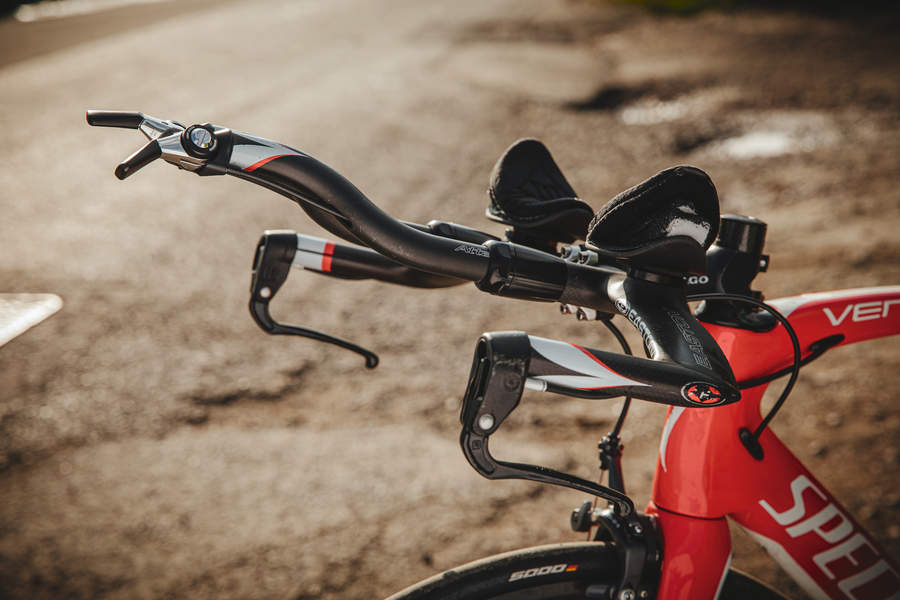
To get my shoulders even narrower we moved on to my hands. This sounds odd, but if you raise your hands (on the ends of the bars) it’s easier to shrug your shoulders in. You can also then tuck your head in behind your hands. Sadly we were limited again. We rotated the base bar in the stem clamp to raise the extensions, but this increased the frontal area of the wing profile of the base bar which is meant to sit horizontally.
There was a trade off to be had here. How high could we go before the gains of raising my hands were lost by the increased frontal area of the base bar. It was pure guesswork sadly.
I ordered some basic aluminium extensions with greater rise only to find they didn't fit. All aero extensions have a 32mm diameter, Easton had made theirs with 34mm, so not only does the bar have poor adjustability, extras and add ons aren't available. That £700 pricetag suddenly didn’t seem so ‘fast’.
Once we had them in what we felt was their optimum position Hutch asked me to pull myself forward. This narrowed my shoulders again and brought my head down a little. "Yeah! he said. "I quite like that."
"Erm," I replied. "You don't expect me to actually ride in this position do you?"
"What's wrong?" he asked.
"I've been in this position for ten seconds and my neck and arms are already in agony!"
"Do you want to go faster or not?"
He was half joking, half serious. If I wanted to optimise my aero position I was going to have to get used to riding like this.
Maintaining power in an aero position
Over lunch Hutch explained how finding a good position was just the start. I was now going to have to get used to it. Jumping into a TT position after 25 years of riding road bikes could lose me 30 watts straight away. Maybe more. And while I might gain the equivalent in a lowered cda, if I wanted to keep them all and actually go any faster this TT bike was now going to have to be my training bike. I had to get all my power out in this new position.
Not only that, the stresses on my arms were completely different to those experienced on a road bike. My early rides in the position left my neck and triceps in a fair bit of discomfort. But gradually, over time the position felt more natural to the point where I actually came to quite like it.
One of Hutches best seasons came after he built himself a winter TT bike. Mudguards and all. Every ride he did was in the TT position and by the time the season started he could put out more power on his TT bike than he could his road bike. I didn’t have that long, so had to cram in the rides and leave the road bike to gather dust.
But the losses in power were real. Just before I started riding the TT bike I’d done an ftp test on my road bike. I managed 241 watts. After six week’s of solid training on the tt bike I was feeling good and did my next FTP test in the TT position. I buried myself over the 20 minute effort and ended it happy that I couldn’t have gone any harder. ‘Congratulations - you’ve raised your FTP' flashed up on screen. Yes! Nailed it! I thought. ‘Your new ftp is 242’
While that was just about the most demoralising moment of my riding this year I was at least getting out the same power in a much faster position, the outcome was much better results in the time trials. Interestingly, soon after I did this test I did sweetspot efforts on a training ride on my road bike and comfortably held 269 watts for ten minutes. This however was using a different power metre, so all it really proved was that my watts were a movable feast. Interpreting them was little more than an educated guess.
Putting the aero theory to the test

My first test on the TT bike came in late June on a 7.3 mile sporting course. I’d ridden the same course earlier in the year on the road bike and clocked 19.10 minutes. It was however a very cold evening in early May, so not a fast night. On the TT bike I did a 17.46. A one minute 24 second improvement over seven miles was not to be sniffed at. Of course it’s hard to compare like for like due to wind, temperature and other conditions but I’d beaten all but one of my club mates, leaping ahead of several riders who’d beaten me in May. I was happy with that.
The real test came at the end of July, on the local 10.1 mile Bletchingley TT circuit, a lumpy course with fast descents and two short, sharp climbs. My season’s target had been the interclub against our local rivals. They’d regularly beaten us in previous years and we wanted the title back. Last summer at my one TT of the year on this course I’d ridden a 29.34 on my road bike. With the improved position, better kit and training, could I improve it? And if so, by how much?
I’d done all the training I could squeeze in and even done a mini taper. I ran through a warm up (again provided by Dr Hutch) and felt good going into it. I was happy with how I paced it, but perhaps held back a little too much on the climbs. I stopped the clock at 27.51 minutes, I was third fastest overall and second fastest from my club. And we won the interclub. I was also happy that my normalised power was 263 watts. Ten watts higher than my 20 minute power logged in my earlier ftp test on the turbo.
Over the course of the year I’d improved my fitness and improved all my times on local courses. I’d beaten several club mates (all friendly rivalry of course) who had been beating me for years and had learnt a lot about aerodynamics.
But best of all, the whole project had given me a clear focus for 2021 and I’d thoroughly enjoyed my riding. All I’ve got to do now is keep getting faster in 2022.
Future aero upgrades
The pursuit of speed is strangely addictive. WHen you set out with the mindset of, how can I make myself a bit fastser, you never stop asking the question. Slightly longer socks, a different helmet, change my hand position ….. The list goes on. So what could I do next? In reality, with that bike and with a limited budget the only thing I could now do is keep training in that position. Anything more and I’d have to start spending some serious money.
Rear disc wheel
Apparently faster on almost any kind of course. It’s a fairly major expense though. A quick look online turned up second hand wheels starting at £300 for a Corima up to £700 for a Zipp.
Front end
Although I’m unable to get the front end much lower with this saddle position, a more adjustable set of bars would help. Ideally the base bar would be flat and the extensions would have greater rise on them to get my hands up a bit higher to narrow my shoulders and punch a hole in the air.
Oversocks
I ran with aero socks this summer, a version that covered the shoes might make a fraction of a second difference.
Helmet
The Lazer is designed for those in a better position than me. With my head as high as it is a stubby lid might be slightly better.
Dream scenario
Tt bike with rear disc and deeper front wheel, plus an hour in a windtunnel. I’ll have a quick look down the back of the sofa in case there’s a spare £10k lying around. If not, I guess I’ll just have to train a little harder.
Structured training
This is something I’ve never done. Instead I tend to use three or four go to turbo sessions and regularly use them. While my fitness did improve significantly this year, I was left wondering if it could have been a little better.
This article was first published in Cycling Weekly magazine, on December 30. Subscribe online and get the magazine delivered direct to your door every week.

Thank you for reading 20 articles this month* Join now for unlimited access
Enjoy your first month for just £1 / $1 / €1
*Read 5 free articles per month without a subscription

Join now for unlimited access
Try first month for just £1 / $1 / €1

Editor of Cycling Weekly magazine, Simon has been working at the title since 2001. He fell in love with cycling 1989 when watching the Tour de France on Channel 4, started racing in 1995 and in 2000 he spent one season racing in Belgium. During his time at CW (and Cycle Sport magazine) he has written product reviews, fitness features, pro interviews, race coverage and news. He has covered the Tour de France more times than he can remember along with two Olympic Games and many other international and UK domestic races. He became the 130-year-old magazine's 13th editor in 2015.
-
 Positive signs for UK bike industry as Halfords cycling sales grow
Positive signs for UK bike industry as Halfords cycling sales growRetailer admits that the impact of Donald Trump's tariffs remains to be seen
By Tom Thewlis
-
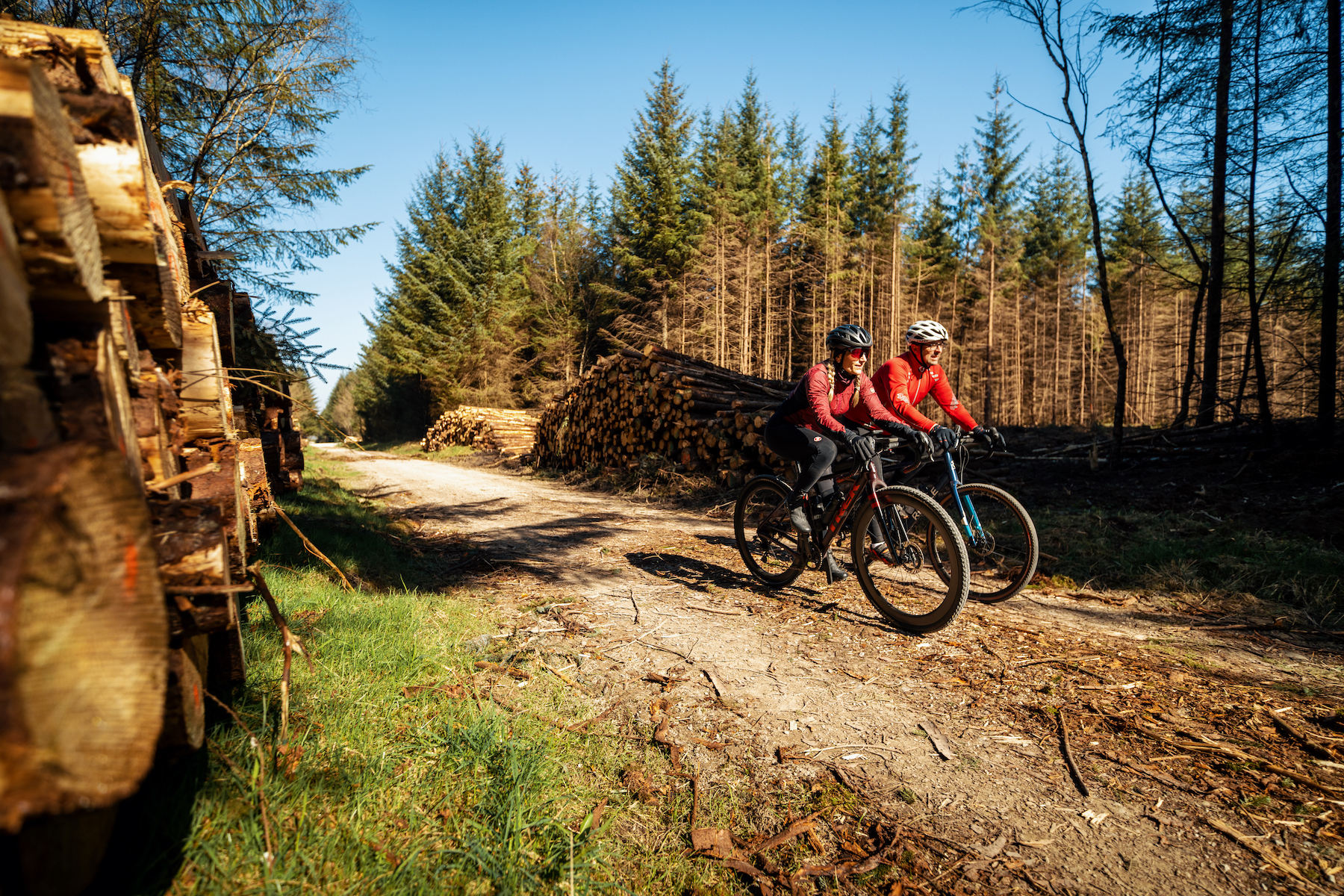 'We don't own gravel - it's a community thing': the spirit of gravel is safe, say British Gravel Championship organisers
'We don't own gravel - it's a community thing': the spirit of gravel is safe, say British Gravel Championship organisersCycling Weekly travels to Dalby Forest to ride the championship course and find out where we go from here
By James Shrubsall